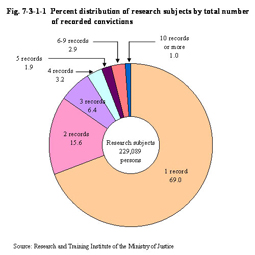| Previous Next Index Image Index Year Selection | |
|
|
2 Summary of research subjects and research subjects of elderly offenders Fig. 7-3-1-1 Percent distribution of research subjects by total number of recorded convictions Fig. 7-3-1-1 includes not only those with recorded convictions at an age of 65 or older but also those who committed offenses when young or late middle age and had become elderly by the time the research was conducted (no limitations were set on their age at the time of committing offenses). Fig. 7-3-1-2 shows the percent ratio of the research subjects of elderly offenders to the research subjects, by total number of recorded convictions.Fig. 7-3-1-2 Percent distribution of research subjects with recorded convictions at 65 or older by total number of recorded convictions This figure reveals that, as the total number of recorded convictions increases, the percent ratio of research subjects of elderly offenders also increases. Of those with a total number of 10 or more recorded convictions, 16.7% had committed offenses after becoming elderly.The percent distribution of the number of criminal records of research subjects of elderly offenders at the age of 65 or older by type of offense reveals that theft was the highest, followed by injury/assault, Wastes Disposal Act violations, and fraud, in that order (see Fig. 7-3-1-3). Fig. 7-3-1-3 Percent distribution of number of recorded convictions of research subjects at the age of 65 or older by type of offense |


